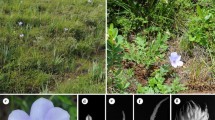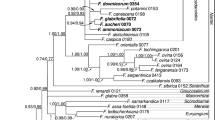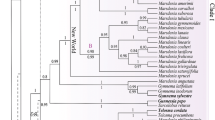Abstract
Maximum parsimony, maximum likelihood, and Bayesian analyses of nuclear ribosomal DNA internal transcribed spacer sequences were used to infer the phylogenetic affinities and historical biogeography of Angelica and its allies (Apiaceae tribe Selineae), with emphasis on those species of Angelica and Peucedanum endemic to the Hengduan Mountains of south-central China. Results of these analyses corroborate a monophyletic Angelica (Angelica sensu stricto) upon the inclusion of Coelopleurum, Czernaevia, and one of two examined species of Ostericum, but with the exclusion of several species previously attributable to Angelica. Angelica oncosepala and A. likiangensis arise within the genus Heracleum in tribe Tordylieae; the former is recognized under its original name, Heracleum oncosepalum. Angelica sinensis, A. tianmuensis and A. paeoniifolia arise within the Sinodielsia clade of previous circumscription, closely related to Levisticum officinale. Angelica anomala is a sister group to Ostericum grosseserratum in the previously delimited Acronema clade. Angelica apaensis and A. decursiva, taxa whose phylogenetic affinities have previously been controversial, are confirmed within Angelica. Northeast Asia (including Japan, northeast China, Korea and adjacent areas of Russia), Western Europe, and North America are inferred to be ancestral areas of Angelica based on optimal solutions of a dispersal-vicariance analysis, with the Hengduan Mountains likely providing a refugium for Angelica during the latter part of the Tertiary.



Similar content being viewed by others
References
Ajani Y, Ajani A, Cordes JM, Watson MF, Downie SR (2008) Phylogenetic analysis of nrDNA ITS sequences reveals relationships within five groups of Iranian Apiaceae subfamily Apioideae. Taxon 57:383–401
Akaike H (1974) A new look at the statistical model identification. IEEE Trans Autom Control 19:716–723
Burland TG (2000) DNASTAR’s Lasergene sequence analysis software. Methods Mol Biol 132:71–91
Chen XY, Heywood VH (1988) Systematic studies in Czernaevia Turcz. (Umbelliferae). Acta Phytotaxon Sin 26:29–32
Chen XY, Yuan CQ (1987) The generic position of Zihua Qianhu and its comparative taxonomic studies with Korean Danggui. J Nanjing Univ 23:23–31
Chen WW, He XJ, Zhang XM, Pu JX (2007) Pollen morphology of the genus Angelica from southwest China and its systematic evolution analysis. Acta Bot Boreal Occident Sin 27:1364–1372
Downie SR, Katz-Downie DS (1996) A molecular phylogeny of Apiaceae subfamily Apioideae: evidence from nuclear ribosomal DNA internal transcribed spacer sequences. Am J Bot 83:234–251
Downie SR, Ramanath S, Katz-Downie DS, Lianas E (1998) Molecular systematics of Apiaceae subfamily Apioideae: phylogenetic analyses of nuclear ribosomal DNA internal transcribed spacer and plastid rpoC1 intron sequences. Am J Bot 85:563–591
Downie SR, Watson MF, Spalik K, Katz-Downie DS (2000) Molecular systematics of Old World Apioideae (Apiaceae): relationships among some members of tribe Peucedaneae sensu lato, the placement of several island-endemic species, and resolution within the apioid superclade. Can J Bot 78:506–528
Downie SR, Plunkett GM, Watson MF, Spalik K, Katz-Downie DS, Valiejo-Roman CM, Terentieva EI, Troitsky AV, Lee BY, Lahham J, El-Oqlah A (2001) Tribes and clades within Apiaceae subfamily Apioideae: the contribution of molecular data. Edinburgh J Bot 58:301–330
Downie SR, Hartman RL, Sun F-J, Katz-Downie DS (2002) Polyphyly of the spring-parsleys (Cymopterus): molecular and morphological evidence suggests complex relationships among the perennial endemic genera of western North American Apiaceae. Can J Bot 80:1295–1324
Doyle JJ, Doyle JL (1987) A rapid DNA isolation procedure for small quantities of fresh leaf tissue. Phytochem Bull 19:11–15
Guindon S, Gascuel O (2003) A simple, fast, and accurate algorithm to estimate large phylogenies by maximum likelihood. Syst Biol 52:696–704
Huelsenbeck JP, Ronquist F (2001) MRBAYES: Bayesian inference of phylogenetic trees. Bioinformatics 17:754–755
Katz-Downie DS, Valiejo-Roman CM, Terentieva EI, Troitsky AV, Pimenov MG, Lee B, Downie SR (1999) Towards a molecular phylogeny of Apiaceae subfamily Apioideae: additional information from nuclear ribosomal DNA ITS sequences. Plant Syst Evol 216:167–195
Lauranson J, Vekemans X, Lefebvre C, Jay M (1995) Flavonoid profiles variation in Armeria maritima (Mill.) Willd. Biochem Syst Ecol 23(3):319–329
Lee SB, Rasmussen SK (1998) Phylogenetic analysis of rDNA internal transcribed spacer of Angelica, Bupleurum and Peucedanum species. Risø-R-1091 (EN) Information Service Department, Risø National Laboratory, Roskilde, Denmark
Meng DY, Zhou SD, He XJ, Ma YH, Wang CB (2004) Pollen morphology of the genus Peucedanum from Sichuan and its systematic significance. Acta Bot Boreal Occident Sin 24:2341–2345
Milne RI (2006) Northern hemisphere plant disjunctions: a window on Tertiary land bridges and climate change? Ann Bot 98:465–472
Myers N, Mittermeier RA, Mittermeier CG, da Fonseca GAB, Kent J (2000) Biodiversity hotspots for conservation priorities. Nature 403:853–858
Nie ZL, Gu ZJ, Sun H (2002) Cytological study of Tibetia (Fabaceae) in the Hengduan Mountains region, China. J Plant Res 115:17–22
Nylander JAA (2004) MrModeltest 2.0. Program distributed by the author. Evolutionary Biology Centre, Uppsala University. Uppsala, Sweden. Available at: http://www.abc.se/~nylander/
Pan ZH, Liu XT, Sheh ML (1991) A study on karyotypes of eight species and geographical distribution of Angelica (Umbelliferae) in Sichuan. Acta Phytotaxon Sin 29:431–438
Pan ZH, Zhuang TD, Yao XM, Sheng N (1994) A study on karyotypes and geographical distribution of Angelica and related genera (Umbelliferae) in China. Acta Phytotaxon Sin 32:419–424
Pimenov MG (1986) Kitagawia—a new Asiatic genus of the family Umbelliferae. Bot Zhurn 71:942–949
Pimenov MG, Kljuykov EV (2003) Notes on some Sino-Himalayan species of Angelica and Ostericum (Umbelliferae). Willdenowia 33:121–137
Pimenov MG, Leonov MV (1993) The Genera of the Umbelliferae. A Nomenclator. Royal Botanic Gardens, Kew, London
Posada D, Crandall KA (1998) Modeltest: testing the model of DNA substitution. Bioinformatics 14:817–818
Qin HZ, Li BY, Wu ZJ, Pan ZH (1995) On the fruit anatomy of Angelica L. (s.l.) of East Asia and North America and its evolution. Acta Bot Boreal Occident Sin 15:48–54
Ronquist F (1997) Dispersal–vicariance analysis: a new approach to the quantification of historical biogeography. Syst Biol 46:195–203
She ML, Pu FT, Pan ZH, Watson MF, Cannon JFM, Holmes-Smith I, Kljuykov EV, Phillippe LR, Pimenov MG (2005) Apiaceae. In: Flora of China Editorial Committee (ED), Flora of China, vol. 14, Missouri Botanical Garden Press, St. Louis, MO, pp 1–205
Sheh ML, Su P, Pan ZH (1997) The comparative study of pollen morphology of Angelica L. between East Asia and North America. J Plant Resour Environ 6:41–47
Shneyer VS, Kutyavina NG, Pimenov MG (2003) Systematic relationships within and between Peucedanum and Angelica (Umbelliferae-Peucedaneae) inferred from immunological studies of seed proteins. Plant Syst Evol 236:175–194
Solov’eva NM, Pimenov MG, Vasil’eva MG, Zigareva NN, Turkov VD (1985) Karyotaxonomic study of some species of Peucedanum (Umbelliferae). Plant Syst Evol 151:89–101
Spalik K, Downie SR (2007) Intercontinental disjunctions in Cryptotaenia (Apiaceae, Oenantheae): an appraisal using molecular data. J Biogeogr 34:2039–2054
Spalik K, Reduron JP, Downie SR (2004) The phylogenetic position of Peucedanum sensu lato and allied genera and their placement in tribe Selineae (Apiaceae, subfamily Apioideae). Plant Syst Evol 243:189–210
Swofford DL (2003) PAUP*: Phylogenetic analysis using parsimony (* and Other Methods). Version 4.0b10. Sinauer, Sunderland, MA
Thompson JD, Gibson TJ, Plewniak F, Jeanmougin F, Higgins DG (1997) The ClustalX windows interface: flexible strategies for multiple sequence alignment aided by quality analysis tools. Nucleic Acids Res 24:4876–4882
Vasil’eva MG, Pimenov MG (1991) Karyotaxonomical analysis in the genus Angelica (Umbelliferae). Plant Syst Evol 177:117–138
Wang FY, Gong X, Hu CM, Hao G (2008) Phylogeography of an alpine species Primula secundiflora inferred from the chloroplast DNA sequence variation. J Syst Evol 46:13–22
Wen J (2000) Internal transcribed spacer phylogeny of the Asian and eastern North America disjunct Aralia sect. Dimorphanthus (Araliaceae) and its biogeographic implications. Int J Plant Sci 161:959–966
White TJ, Bruns TD, Lee SB, Taylor JW (1990) Amplification and direct sequencing of fungal ribosomal RNA genes for phylogenetics. In: Innis N, Gelfand D, Sninsky J, White J (eds) PCR—protocols and applications—a laboratory manual. Academic, New York, pp 315–322
Winter PJD, Magee AR, Phephu N, Tilney PM, Downie SR, van Wyk BE (2008) A new generic classification for African peucedanoid species (Apiaceae). Taxon 57:347–364
Xiang QY, Soltis DE, Soltis PS, Manchester SR, Crawford DJ (2000) Timing the eastern Asian–eastern North American floristic disjunction: molecular clock corroborates paleontological estimates. Mol Phylogenet Evol 15:462–472
Xue HJ, Yan MH, Lu CM, Wang NH, Wu GR (2007) Taxonomic study of Angelica from East Asia: inferences from ITS sequences of nuclear ribosomal DNA. Acta Phytotaxon Sin 45:783–795
Yokota Y, Kawata T, Iida Y, Kato A, Taifuji S (1989) Nucleotide sequences of the 5.8S rRNA gene and internal transcribed spacer regions in carrot and broad bean ribosomal DNA. J Mol Evol 29:294–301
Zhang QY, He XJ, Zhang YC, Luo P, Wu N (2005a) Study on karyotypes of six species in Angelica from Sichuan, China. Acta Bot Yunnan 27:539–544
Zhang QY, He XJ, Zhang YC, Luo P, Wu N (2005b) Anatomical studies on fruits and petioles of 8 species of Angelica L. from Sichuan province. J Wuhan Bot Res 23:549–554
Zhang XM, He XJ, Pu JX, Chen WW (2006) Studies on karyotypes of five populations of three species in Umbelliferae from China. J Wuhan Bot Res 24:408–412
Zhou J, Peng H, Downie SR, Liu ZW, Gong X (2008) A molecular phylogeny of Chinese Apiaceae subfamily Apioideae inferred from nuclear ribosomal DNA internal transcribed spacer sequences. Taxon 57:402–416
Acknowledgments
This work was supported by the National Natural Science Foundation of China, Grant No. 30670146, and the National Infrastructure of Natural Resources for Science and Technology, Grant No. 2005DKA21403. The authors greatly appreciate Dr. Kun Wei for comments on an early draft of the manuscript and one anonymous reviewer for helpful criticism.
Author information
Authors and Affiliations
Corresponding author
Appendix
Appendix
Taxa, references, and GenBank accession numbers for all nrDNA ITS sequences used in this study.
Angelica acutiloba (Siebold & Zuccarini) Kitagawa, AJ131291, GenBank; A. ampla A. Nelson, U79597, U79598, Downie et al. 1998; A. amurensis Schischkin in Schischkin & Bobrov, DQ263581, Xue et al. 2007; A. anomala Avé-Lallemant in Fischer & Avé-Lallemant, DQ263582, GenBank; A. apaensis R. H. Shan & C. Q. Yuan, EU418381, N: 31°54.211′, E: 102°39.723′, this study; DQ263583, Xue et al. 2007, endemic in Hengduan Mountains; A. archangelica L., U30576, U30577, Downie et al. 1998; A. arguta Nutt. ex Torr. & A. Gray, U79599, U79600, Downie et al. 1998; A. biserrata C. Q. Yuan & R. H. Shan, DQ270207, Xue et al. 2007; A. breweri A. Gray, U78396, U78456, Downie et al. 1998; A. cartilaginomarginata var. foliosa C. Q. Yuan & R. H. Shan, DQ263589, GenBank; A. cincta H. Boissieu, AF008601, AF009080, Katz-Downie et al. 1999; A. dahurica (Fischer ex Hoffmann) Bentham & J. D. Hooker ex Franchet & Savatier, EU418374, N: 25°04.106′, E: 102°42.212′, this study; A. decurrens (Ledeb.) B. Fedtsch., AF008599, AF009078, Katz-Downie et al. 1999; A. decursiva (Miquel) Franchet & Savatier, EU418375, N: 25°04.202′, E: 102°42.198′, this study; A. fargesii H. de Boissieu, EU418376, N: 31°48.514′, E: 108°46.539′, this study, endemic in Hengduan Mountains; A. furcijuga Kitagawa, DQ278164, Xue et al. 2007; A. genuflexa Nuttall., DQ263566, Xue et al. 2007; A. gigas Nakai, DQ263580, Xue et al. 2007; A. grayi (Coult. & Rose) Coult. & Rose., AY146825, AY146891, Sun et al. 2004; A. japonica A. Gray, DQ278166, Xue et al. 2007; A. kangdingensis R. H. Shan & F. D. Pu, DQ263584, Xue et al. 2007, endemic in Hengduan Mountains; A. keiskei (Miq.) Koidz., DQ263562, Xue et al. 2007; A. koreana Maxim. = (Ostericum grosseserratum Maxim.), AF455749, GenBank; A. laxifoliata Diels, EU647210, N: 30°03.543′, E: 101°48.881′, this study; DQ263586, Xue et al. 2007, endemic in Hengduan Mountains; A. lignescens Danton & Reduron, AY179030, Spalik et al. 2004; A. likiangensis H. Wolff, DQ263587, Xue et al. 2007, endemic in Hengduan Mountains; A. maowenensis C. Q. Yuan & R. H. Shan, DQ263585, Xue et al. 2007; EU236157, Zhou et al. 2008, endemic in Hengduan Mountains; A. megaphylla Diels, EU418377, N: 29°05.200′, E: 107°15.114′, this study, endemic in Hengduan Mountains; A. morii Hayata, DQ263578, Xue et al. 2007; A. nitida H. Wolff, EU418378, N: 32°44.529′, E: 103°42.045′, this study, endemic in Hengduan Mountains; A. omeiensis C. C. Yuan & R. H. Shan., DQ263576, Xue et al. 2007, endemic in Hengduan Mountains; A. oncosepala Handel-Mazzetti, EU418382, N: 27°06.774′, E: 100°11.322′, this study, endemic in Hengduan Mountains; A. paeoniifolia C. Q. Yuan & R. H. Shan, FJ237533, N:29°39.221′, E:94°32.803, this study, endemic in Hengduan Mountains; A. pinnata S. Watson, AF358465, AF358532, Downie et al. 2002; A. polymorpha Maxim., U78415, U78475, Downie et al. 1998; A. pseudoselinum H. de Boissieu, EU418379, N: 30°45.008′, E: 102°78.6022′, this study, endemic in Hengduan Mountains; A. pubescens (R. H. Shan & C. Q. Yuan) C. Q. Yuan & R. H. Shan, DQ263567, Xue et al. 2007; A. purpureifolia Chuang, AY548229, GenBank; A. roseana Henderson, AF358466, AF358533, Downie et al. 2002; A. sachalinensis Maxim., U78413, U78473, Downie et al. 1998; A. sinensis (Oliver) Diels., FJ204235, N:30°41.452′; E:104°09.315′, this study, endemic in Hengduan Mountains; A. sylvestris Linnaeus, U78414, U78474, Downie et al. 1998; A. tianmuensis Z. H. Pan, & T. D. Zhuang, DQ270194, Xue et al. 2007; A. valida Diels, EU418380, N: 29°06.985′, E: 107°14.028′, this study, endemic in Hengduan Mountains; Coelopleurum lucidum (L.) Fernald, DQ270196, Xue et al. 2007; C. saxatile (Turcz. ex Ledeb.) Drude, DQ270195, Xue et al. 2007; Czernaevia laevigata Turcz., DQ270197, Xue et al. 2007; Heracleum aconitifolium Woronow, AF008625, AF009104, Katz-Downie et al. 1999; H. candicans Wall. ex DC., DQ516378, Spalik and Downie 2007; H. lanatum Michx., U30542, U30543, Downie and Katz-Downie 1996; H. moellendorffii Hance, AF164828, AF164853, Downie et al. 2000; H. rigens Wall. ex DC., U30548, U30549, Downie and Katz-Downie 1996; H. sphondylium L., U30544, U30545, Downie and Katz-Downie 1996; Levisticum officinale W. D. J. Koch, U78389, U78449, Downie et al. 1998; Ostericum grosseserratum (Maxim.) Kitaga., DQ270199, Xue et al. 2007; O. koreanum (Maxim.) Kitag., AY548212, GenBank; Peucedanum achaicum Halácsy. (= Holandrea achaia (Halácsy) Spalik, Reduron & S. R. Downie), AY164832, AY164857, Downie et al. 2000; P. bourgaei Lange, AF495818, AF495819, Spalik et al. 2004; P. caucasicum (M. Bieb.) K. Koch. (= Holandrea caucasica (M. Bieb.) Spalik, Reduron & S. R. Downie), AF008618, AF009097, Katz-Downie et al. 1999; P. coriaceum Rchb., AF495824, AF495825, Spalik et al. 2004; P. delavayi Franchet, EU418386, N: 26°95.016′, E: 100°00.459′, this study, endemic in Hengduan Mountains; P. dissolutum (Diels) H. Wolff, EU418388, N: 29°07.372′, E: 107°15.335′, this study, endemic in Hengduan Mountains; P. elegans Komarov, EU418385, N: 27°10.202′, E: 99°98.886′, this study; P. gallicum Latourr., AF495816, AF497817, Spalik et al. 2004; P. japonicum Thunberg ex A. Murray, AF495826, AF495827, Spalik et al. 2004; P. ledebourielloides Franch, DQ270200, Xue et al. 2007; P. morisonii Besser ex Schult., U78406, U78466, Downie et al. 1998; P. officinale L., AF495820, AF495821, Spalik et al. 2004; P. praeruptorum Dunn, EU418383, N: 31°50.005′, E: 108°60.141′, this study; P. pschavicum Boiss. (= Holandrea pschawica (Boiss.) Reduron, Charpin & Pimenov), AF008619, AF009098, Katz-Downie et al. 1999; P. rubricaule R. H. Shan & M. L. Sheh, EU418387, N: 27°42.403′, E: 100°09.251′, this study, endemic in Hengduan Mountains; P. terebinthaceum (Fisch. ex Trevis.) Fisch. ex Turez. (= Kitagawia terebinthacea (Fisch. ex Spreng.), AF164833, AF164858, Downie et al. 2000; P. zedelmeyerianum Manden., AF164834, AF164859, Downie et al. 2000; Pleurospermum decurrens Franchet, AF164837, AF164862, Downie et al. 2000; Pleurospermum foetens Franchet, AF008639, AF009118, Katz-Downie et al. 1999; Pleurospermum uralense Hoffmann, AF008638, AF009117, Katz-Downie et al. 1999.
Rights and permissions
About this article
Cite this article
Feng, T., Downie, S.R., Yu, Y. et al. Molecular systematics of Angelica and allied genera (Apiaceae) from the Hengduan Mountains of China based on nrDNA ITS sequences: phylogenetic affinities and biogeographic implications. J Plant Res 122, 403–414 (2009). https://doi.org/10.1007/s10265-009-0238-4
Received:
Accepted:
Published:
Issue Date:
DOI: https://doi.org/10.1007/s10265-009-0238-4




